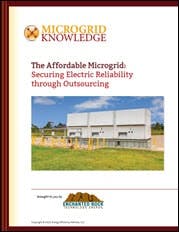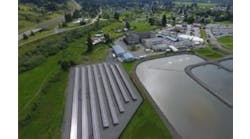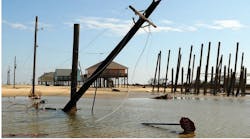Microgrids are not just for reliability. They also are used to manage energy pricing through leveraging wholesale markets. We explain how in part five of this six-part Microgrid Knowledge Special Report Series on reliability-as-a-service and the affordable microgrid.
Download the full report.
Gas-fired microgrids offer operational flexibility that is crucial to today’s electric grid and complex power markets. Growing levels of renewable energy penetration are changing the nature of power markets, particularly in competitive wholesale markets.
That is especially true in Texas, where 90 percent of the electricity consumed in the state flows through the Electric Reliability Council of Texas (ERCOT).
ERCOT is an independent system operator (ISO) which, like a regional transmission organization (RTO), acts as a clearinghouse between electricity supply (generation) and demand (load). ISOs and RTOs are not-for-profit organizations that manage and operate wholesale power markets but do not themselves own any generation or transmission assets.
ISO participants typically include a wide variety of power producers, from operators of coal-fired and gas-fired plants to wind farms and nuclear power plants. They also include load serving entities, such as regulated distribution utilities.
Seven ISO/RTOs in the United States and three in Canada serve about 60 percent of North America’s electric load. Some serve a single state such as California or New York. Most are regional, such as PJM Interconnection, the largest among them, which serves 13 states and the District of Columbia.
Wholesale power markets and microgrids
The basic mechanism of an ISO/RTO is the day-ahead market. Rules vary by region, but generators typically bid into the day-ahead market. The grid operator then ranks the bids and dispatches the generators from the lowest to the highest priced until all forecast load is filled.
In addition to a day-ahead market, ISO/RTOs can oversee markets for a variety of other functions that are needed to continuously balance supply and demand of electricity. These ancillary services include services referred to as frequency regulation, spinning reserves and operating reserves.
When large amounts of surplus wind energy enter the grid, prices can go negative due to excess power availability. When the wind suddenly dies, the grid may run short on power. Traditional fossil fuel generators cannot ramp up quickly enough to meet the near-instant demand for power.
Wholesale markets across the country have seen growing levels of renewable energy penetration—particularly Texas. Last spring, ERCOT hit a record with wind power supplying just over 48 percent of load. The Southwest Power Pool also set a record with wind power supplying nearly 44 percent of load.
While high levels of wind power may be good for the environment, their unpredictable nature can create challenges on the smooth operation of the grid. When large amounts of surplus wind energy enter the grid, prices can go negative due to excess power availability. When the wind suddenly dies, the grid may run short on power and traditional fossil fuel generators cannot ramp up quickly enough to meet the near-instant demand for power.
RTOs and ISOs manage 60 percent of US power supply.
In ERCOT, the growing presence of wind power combined with price volatility has made it tough for many traditional power plants to operate profitably. A total of about 5,625 MW of fossil fuel capacity in ERCOT (enough to supply the Austin and San Antonio, Texas metropolitan areas combined) is scheduled to be retired or mothballed in 2018. Even new, modern gas-fired combined-cycle plants, such as Panda Energy’s Temple plant, have had difficulty operating in this challenging market. In April 2017, Panda filed for bankruptcy court protection for the plant.
“When we sell to the grid, we respond very quickly to help buffer the intermittent nature of wind and solar, thus enabling continued growth of these renewables and decarbonization of electricity.” – Thomas McAndrew, ERock
With the closing of these power plants, the Department of Energy (DOE) introduced a Notice of Proposed Rulemaking (NOPR) that would provide cost recovery for coal and nuclear plants that keep fuel on site. The NOPR was rejected by the Federal Energy Regulatory Commission (FERC), as there was no evidence to support the claim that these traditional power plants aid in grid resiliency. FERC Commissioner Richard Glick, however, acknowledged microgrids as a technology that does.
Resiliency is a defining feature of microgrids and industry leaders are actively discussing the benefits they can provide for the nation’s energy markets.
“ERock builds and operates ultra-clean and quiet resiliency microgrids specifically to provide electricity for critical services when the transmission and distribution cannot deliver,” Thomas McAndrew, president and CEO of Enchanted Rock, said. “We own and operate these microgrids, providing electrical resiliency as a very affordable service by maximizing revenues from selling to the electric grid, thus minimizing the price to our customer. When we sell to the grid, we respond very quickly to help buffer the intermittent nature of wind and solar, thus enabling continued growth of these renewables and decarbonization of electricity.”
Innovative microgrids could be the answer our power grid is looking for.
Microgrids can operate both within the grid and independently of it. McAndrew said ERock has adapted its business model to fit the economics of the modern wholesale market by looking beyond average wholesale market prices and at the more granular price opportunities resulting from intermittent resources. Hence, the operational flexibility of a gas-fired engine is an important consideration in the modern electric power market.
How microgrids operate during price spikes
When continuously monitoring the wholesale power market, it becomes apparent that the “average price is made up of a lot of negative price periods and frequent price spikes,” McAndrew said.
A theme common to both basic and advanced microgrids is their ability to island, or disconnect, from the central grid and use their own energy assets to provide power to their customers for at least 24 hours.
For example, ERock’s microgrids at the 105 H.E.B grocery stores across Texas allow the stores to remain in business when the surrounding grid goes down. During normal operation, however, ERock sells the output from the generator into ERCOT’s energy and ancillary service markets, and offsets its capital and operating costs.
Any individual microgrid at one of the H.E.B stores may be small, but by aggregating them, ERock creates a virtual power plant that, with the assistance of software controls, can watch for sudden changes in market conditions. Hence, a simultaneous spike in load and drop in wind production could indicate a need for fast responding generation.
ERock’s generators can respond more quickly than the fastest, centralized quick response generators, and much faster than the traditional natural gas combined cycle plants that provide much of ERCOT’s baseload fossil generation, according to McAndrew. ERock’s generators also respond more quickly than competing generators used for the same purpose, with response times as fast as one minute compared to five minutes for a comparable Wartsila generator. When market conditions change, ERock turns off its virtual power plant.
The ERock model beyond Texas
So far, ERock has employed its model in its home turf of Texas, but the company says it can work in many other parts of North America—and the world. As a result, ERock has begun expanding into other power markets.
Perhaps most important, the ERock approach — reliability-as-a-service — offers universal appeal to a range of potential microgrid customers, including retail stores, manufacturers, business parks, institutions and communities. ERock’s affordable microgrid brings them microgrid reliability with little capital expenditure and a predictable energy cost over time.
In the final chapter of our series on the affordable microgrid, we profile stores that kept the lights on during Hurricane Harvey using ERock microgrids.
This six-part Microgrid Knowledge Special Report Series also previously covered the following topics:
- Microgrid Installation Before Calamity: Resiliency Planning
- Putting a Value on Electric Reliability for Your Operation
- Reliability-as-a-Service: What is an Affordable Microgrid?
- Natural Gas-Fired Microgrids Tout Advantages Over Other Energy Sources
We welcome you to download this special report, “The Affordable Microgrid: Securing Electric Reliability through Outsourcing,” free of charge, courtesy of Enchanted Rock, and to widely distribute the link.









